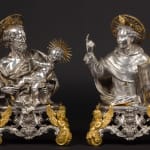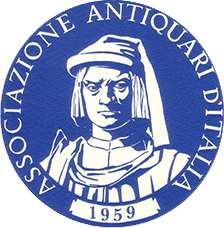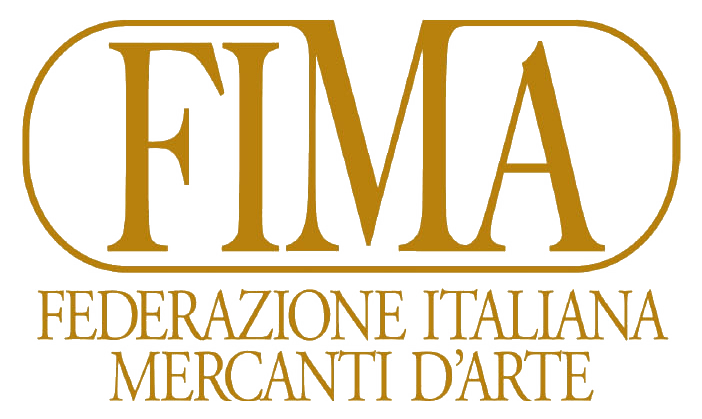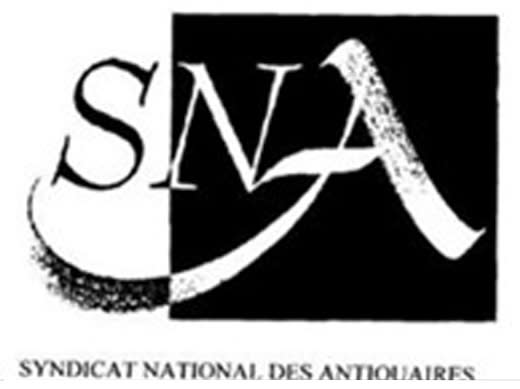Baldassare De Blasio
SAINT JOSEPH WITH THE CHILD, SAINT VINCENT FERRER, Second Half of 18th Century
Silver and gilded bronze
36 x 24.5 x 18 cm
14 1/8 x 9 5/8 x 7 1/8 in
Expertise by Andrea Bacchi
14 1/8 x 9 5/8 x 7 1/8 in
Expertise by Andrea Bacchi
Further images
-
(View a larger image of thumbnail 1
)

-
(View a larger image of thumbnail 2
)

-
(View a larger image of thumbnail 3
)

-
(View a larger image of thumbnail 4
)

-
(View a larger image of thumbnail 5
)

-
(View a larger image of thumbnail 6
)

-
(View a larger image of thumbnail 7
)

-
(View a larger image of thumbnail 8
)

-
(View a larger image of thumbnail 9
)

-
(View a larger image of thumbnail 10
)

-
(View a larger image of thumbnail 11
)

-
(View a larger image of thumbnail 12
)

-
(View a larger image of thumbnail 13
)

These two notable silver busts, based on a calssic reliquirary model, remind instantly of the exceptional ones of the protective Saints in Naples, in the San Gennaro chapel of the...
These two notable silver busts, based on a calssic reliquirary model, remind instantly of the exceptional ones of the protective Saints in Naples, in the San Gennaro chapel of the Duomo, and seem to be precisely datable to the year 1750, or 1756. Underneath both busts, in fact, we find the punzoni of the goldsmiths who licensed the pieces, and the consular one is recognizable also because of the comparison to the one at the back of one of these busts, in a position that granted it perfect conservation : the monogram is “BDBC” reconductable to Baldassare De Blasio (the ‘C’ stood for consul). The stamps of the goldsmith who phisically produced the busts are no longer readable.
The De Blasios were the most famous goldsmiths of the XVIII century in Naples: in addition to Baldassarre, also Andrea, Domenico, Gennaro and Nicola were elected consuls of the corporation in multiple occasions (respectively in 1714, 1720, 1723; in 1725, 1728, 1733, 1735; in 1740, 1741, 1747; in 1750, 1752, 1756, 1776). We are not aware of a stamp used by Baldassare only as a goldsmith and not as a consul, but we are sure that, as for his relatives, he must have had one (we have news of him from 1750 to 1764). The invention of Saint Joseph with the Child is to be attributed to a wooden sculpture signed and by Giuseppe Picano (JOSEPH PICANO S.), now located in the Church of Saint Agostino della Zecca in Naples. It must have been a very fotunate invention, as we are able to tell not only by the date and the sign of the version in Sant’Agostino, but also by the existence of a terracotta replica recently appeared on the market. Giuseppe, son of Francesco Picano, who must have started him son to the technique of carving wood (Francesco is documented as sculptor in 1737 and 1740), is lenghtily reffered to, because of documents and signed artworks, just as a “Scultore di legno”, active in Naples but serving all the Kingdom (in December of 1782, for instance, he would receive a commision for the Immacolata Concezione for the Chiesa Madre in San Giovanni Battista Decollato in Bivogni, Calabria, where it still stands). In addition to that, in 1781, Picano receives payments for “all the marble and plaster scultpures and their models” of the major altar in the Annunziata Church in Naples.
The identification of the Saint represented in the second bust is not an issue, because of the writing in the open book, associated to San Vincenzo Ferrer, whose cult in Naples, lenghtely documented, started being stronger from colera epidemic of 1837, after that he was proclaimed protector of the city (one of his busts was located in the San Gennaro chapel). The quality of modeling, mostly in Saint Joseph, because of the beautiful drapery, remind us of the most famous examples of neapoletan silverwaring of the XVIII century: like the San Rocco by Nicola De Blasio dated 1751 (Guardia Sanframondi, Museo). It is possible that both models were made by Picano , and that he realized them right before modeling the signed and dated Saint Agostino alla Zecca, made after the artwork here presented.
The De Blasios were the most famous goldsmiths of the XVIII century in Naples: in addition to Baldassarre, also Andrea, Domenico, Gennaro and Nicola were elected consuls of the corporation in multiple occasions (respectively in 1714, 1720, 1723; in 1725, 1728, 1733, 1735; in 1740, 1741, 1747; in 1750, 1752, 1756, 1776). We are not aware of a stamp used by Baldassare only as a goldsmith and not as a consul, but we are sure that, as for his relatives, he must have had one (we have news of him from 1750 to 1764). The invention of Saint Joseph with the Child is to be attributed to a wooden sculpture signed and by Giuseppe Picano (JOSEPH PICANO S.), now located in the Church of Saint Agostino della Zecca in Naples. It must have been a very fotunate invention, as we are able to tell not only by the date and the sign of the version in Sant’Agostino, but also by the existence of a terracotta replica recently appeared on the market. Giuseppe, son of Francesco Picano, who must have started him son to the technique of carving wood (Francesco is documented as sculptor in 1737 and 1740), is lenghtily reffered to, because of documents and signed artworks, just as a “Scultore di legno”, active in Naples but serving all the Kingdom (in December of 1782, for instance, he would receive a commision for the Immacolata Concezione for the Chiesa Madre in San Giovanni Battista Decollato in Bivogni, Calabria, where it still stands). In addition to that, in 1781, Picano receives payments for “all the marble and plaster scultpures and their models” of the major altar in the Annunziata Church in Naples.
The identification of the Saint represented in the second bust is not an issue, because of the writing in the open book, associated to San Vincenzo Ferrer, whose cult in Naples, lenghtely documented, started being stronger from colera epidemic of 1837, after that he was proclaimed protector of the city (one of his busts was located in the San Gennaro chapel). The quality of modeling, mostly in Saint Joseph, because of the beautiful drapery, remind us of the most famous examples of neapoletan silverwaring of the XVIII century: like the San Rocco by Nicola De Blasio dated 1751 (Guardia Sanframondi, Museo). It is possible that both models were made by Picano , and that he realized them right before modeling the signed and dated Saint Agostino alla Zecca, made after the artwork here presented.
Publications
A. Bacchi, “San Joseph with the child, San Vincent Ferrer", in A. Bacchi, Ed., Treasures from the Kingdom of the Two Sicilies, London 2025, pp. 166-171, No. 26 (Illustrated).
Join our mailing list
* denotes required fields
We will process the personal data you have supplied in accordance with our privacy policy (available on request). You can unsubscribe or change your preferences at any time by clicking the link in our emails.















